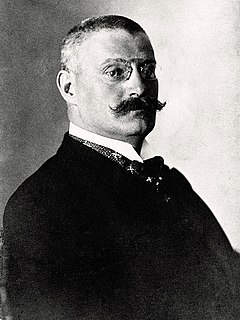
Andreas Felix von Oefele was a German historian and librarian.

The Bavarian Academy of Sciences and Humanities is an independent public institution, located in Munich. It appoints scholars whose research has contributed considerably to the increase of knowledge within their subject. The general goal of the academy is the promotion of interdisciplinary encounters and contacts and the cooperation of representatives of different subjects.

Eugen Ritter von Knilling was the Prime Minister of Bavaria from 1922 to 1924.

Polling Abbey is a former monastery in Polling bei Weilheim, district of Weilheim-Schongau, in Upper Bavaria, Germany.

DukeMaximilian Joseph of Bavaria, known informally as Max in Bayern, was a member of a junior branch of the royal House of Wittelsbach who were Kings of Bavaria, and a promoter of Bavarian folk-music. He is most famous today as the father of Empress Elisabeth of Austria ("Sisi") and great-grandfather of King Leopold III of Belgium.

Hugo Phillip Graf von Lerchenfeld auf Köfering und Schönberg was the representative of the Kingdom of Bavaria in Berlin from 1880 to 1918.

Karl Spruner von Merz, or Karl von Spruner as he preferred to be known, was a German cartographer and scholar.
Anton von Aretin was a German politician, representative of the Bavaria Party and the Christian Social Union of Bavaria (CSU). He was also a member of the Landtag of Bavaria.

Karl August Joseph Maria Donatus, Count of Seinsheim was the Bavarian Finance Minister and President of the Bavarian Chamber of Deputies.

The Bavarian Maximilian Order for Science and Art was first established on 28 November 1853 by King Maximilian II von Bayern. It is awarded to acknowledge and reward excellent and outstanding achievements in the field of science and art. From 1933 onwards the order was no longer awarded, until 1980 when it was reinstated by the then Minister-President of the Free State of Bavaria Franz Josef Strauß. Munich jewellers Hemmerle have been responsible for making the medal since 1905.

Gottfried Landwehr was a German physicist.

Höglwörth Abbey is a former monastery of the Augustinian Canons in Höglwörth, near Anger in Bavaria, in the Archdiocese of Munich and Freising.

Johann Georg von Lori was a Bavarian high official, lawyer and historian. He was the driving force behind the foundation of the Bavarian Academy of Sciences and Humanities in 1759.

Johann Georg Dominicus von Linprun was a Bavarian scientist. He was one of the co-founders of the Bavarian Academy of Sciences.

The Parnassus Boicus was a Bavarian learned society founded in 1722, and the name of a journal published by the society.

Franz Ignaz Oefele was a German painter, etcher, and miniaturist. His name is sometimes spelled "Öffele" and is occasionally seen as "Oeffele-Piekarski", for reasons unknown.

The Historische Lexikon Bayerns or Historical Lexicon of Bavaria is a specialist, historical lexicon about the History of Bavaria, which has been published as a genuine online publication. It is the first specialised lexicon on the history of the Free State of Bavaria and its various regions.
Rudi Tröger is a German painter and university professor. From 1967 to 1992 he was a professor for painting art at the Academy of Fine Arts, Munich.
Horst Leuchtmann was a German musicologist.
The Institute of Bavarian History at the Ludwig Maximilian University (Ludwig-Maximilians-Universität) in Munich is a centre of research and teaching of Bavarian history in a European context. It is located in the building complex of the Bavarian State Archives and in the immediate vicinity of the Bavarian State Library.
















